If you’re a parent, or Christmas shopping for young- or pre-teens, it can sometimes be hard to find comics that are suitable, without the darker elements of violence or adult themes that so many comics seem to emphasize. However, there are a lot of all-ages books out there, comics that aren’t too cloying or sweet, but offer smart, engaging stories and characters that both adults and kids can appreciate, and this week offers a number of examples:
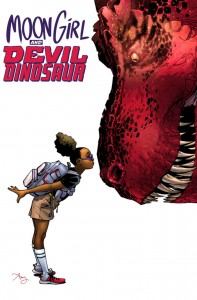 Moon Girl and Devil Dinosaur #1 — Writers: Brandon Montclare and Amy Reeder; Art: Natacha Bustos; Colors: Tamra Bonvillain
Moon Girl and Devil Dinosaur #1 — Writers: Brandon Montclare and Amy Reeder; Art: Natacha Bustos; Colors: Tamra Bonvillain
The Unbeatable Squirrel Girl #2 — Writer: Ryan North; Art: Erica Henderson; Colors: Rico Renzi
Jughead #2 — Writer: Chip Zdarsky; Art: Erica Henderson
Archie #4 — Writer: Mark Waid; Art: Annie Wu; Colors: Andre Szymanowicz with Jen Vaughn
Groot #6 — Jeff Loveness; Art/Colors: Brian Kesinger
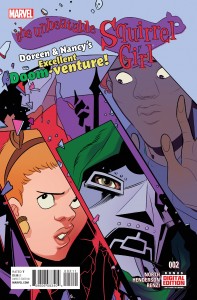 Groo: Friends and Foes #11 (of 12) — Art/Story: Sergio Aragones; Wordsmith: Mark Evanier
Groo: Friends and Foes #11 (of 12) — Art/Story: Sergio Aragones; Wordsmith: Mark Evanier
Marvel’s been slowly building an impressive stable of inclusive, approachable comics, and this week’s debut of Moon Girl and Devil Dinosaur offers another one. It’s got an appealingly-smart and nerdy young heroine, a budding inventor, and naturally she’s picked on and misunderstood in school, ala Peter Parker; also naturally, there’s some prehistoric/scientific oogabooga stuff that ends up dropping Devil Dinosaur into her schoolyard, and you can guess what happens from there. Montclare and Reeder are very good at sketching Lunella’s (yes, of course that’s her name…) character in just a few pages, and making us root 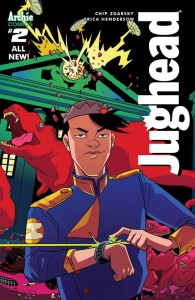 for her, while Bustos has a style that’s just cartoony enough to make the action energetic and a little amusing. This may seem like a silly concept, but it’s a very canny, well-constructed story and world, and deserves to become a hit. If so, it’ll be following in the footsteps of another appealing character with a silly concept: The Unbeatable Squirrel Girl, which also gets by on solid storytelling, humor and heart, helped enormously by North’s ability to both send up and sidestep most comic-book cliches, and refusal to do anything in half-measures (the Twitter sequences on the title page have more plot than most other entire books, and Doreen’s roommate, Nancy, whom most writers would make a pleasant cypher, has no powers but is smart, spunky and totally her own self, and deserves her spot carrying
for her, while Bustos has a style that’s just cartoony enough to make the action energetic and a little amusing. This may seem like a silly concept, but it’s a very canny, well-constructed story and world, and deserves to become a hit. If so, it’ll be following in the footsteps of another appealing character with a silly concept: The Unbeatable Squirrel Girl, which also gets by on solid storytelling, humor and heart, helped enormously by North’s ability to both send up and sidestep most comic-book cliches, and refusal to do anything in half-measures (the Twitter sequences on the title page have more plot than most other entire books, and Doreen’s roommate, Nancy, whom most writers would make a pleasant cypher, has no powers but is smart, spunky and totally her own self, and deserves her spot carrying 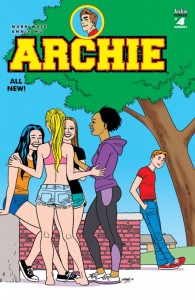 part of the cover and half the book this issue). Then there’s the Erica Henderson art, also totally her own: if at first it looks too simple, look again, because every line is composed for maximum effect, and the layout and composition complement the book’s mix of humor and action perfectly; it’s very hard to make that much hard work look so effortless. Henderson pulls off a similar effect in Jughead, where she draws Archie’s buddy in both serious and humorous modes, as he battles an officious new principal and a bullying gym coach (and daydreams an adventure about being in the Time Police, an indication that writer Chip Zdarsky has dug deeply into previous Archie comics), and acts just like the outcast/trickster hero that we’ve always wanted him to be. Archie itself,
part of the cover and half the book this issue). Then there’s the Erica Henderson art, also totally her own: if at first it looks too simple, look again, because every line is composed for maximum effect, and the layout and composition complement the book’s mix of humor and action perfectly; it’s very hard to make that much hard work look so effortless. Henderson pulls off a similar effect in Jughead, where she draws Archie’s buddy in both serious and humorous modes, as he battles an officious new principal and a bullying gym coach (and daydreams an adventure about being in the Time Police, an indication that writer Chip Zdarsky has dug deeply into previous Archie comics), and acts just like the outcast/trickster hero that we’ve always wanted him to be. Archie itself,  meanwhile, is in the middle of Waid’s “Year One” story about the week that Veronica first came to town, with a flashback to what caused longtime neighbors and best friends Archie and Betty to break up; it’s got some of the truth and poignancy of all growing-up tales, and nails the transition between preteen adolescence and the confusions of puberty nicely (it’s also got a number of variant covers, including the amazing one by Jaime Hernandez shown here: every line in place, with no wasted effort — look at those three lines that indicate the backs of each of Betty’s knees, and consider how they’re in exactly the right place to achieve the desired effect, something that only 35 years of high-level cartooning can accomplish). Groot‘s been another pleasant surprise, and this final issue of his mini-series manages an affecting tale of how he was exiled from his planet for helping a captured
meanwhile, is in the middle of Waid’s “Year One” story about the week that Veronica first came to town, with a flashback to what caused longtime neighbors and best friends Archie and Betty to break up; it’s got some of the truth and poignancy of all growing-up tales, and nails the transition between preteen adolescence and the confusions of puberty nicely (it’s also got a number of variant covers, including the amazing one by Jaime Hernandez shown here: every line in place, with no wasted effort — look at those three lines that indicate the backs of each of Betty’s knees, and consider how they’re in exactly the right place to achieve the desired effect, something that only 35 years of high-level cartooning can accomplish). Groot‘s been another pleasant surprise, and this final issue of his mini-series manages an affecting tale of how he was exiled from his planet for helping a captured 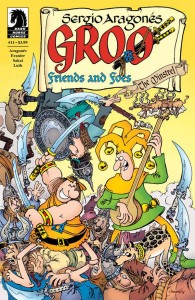 Earth girl, with a theme involving love, friendship and the passage of time that’s both subtle and wise; like so many of the artists on this list, Kesinger’s got a style that’s equally good at exaggerating-for-effect caricature and serious action. Of all the artists on display, though, the oldest and most masterful has to be Sergio Aragones: his Groo (assisted ably by Mark Evanier’s words) is another example of every-line-in-place art, except that Aragones is so swift and generous in his craft that the panels are just stuffed with action: the first page has more drawing than many artists accomplish in an entire issue, and it’s trumped later by a double-page splash of a festival that delivers ten times the detail: over a hundred characters, each an individual, interacting logically with the others, and placed precisely on the page.
Earth girl, with a theme involving love, friendship and the passage of time that’s both subtle and wise; like so many of the artists on this list, Kesinger’s got a style that’s equally good at exaggerating-for-effect caricature and serious action. Of all the artists on display, though, the oldest and most masterful has to be Sergio Aragones: his Groo (assisted ably by Mark Evanier’s words) is another example of every-line-in-place art, except that Aragones is so swift and generous in his craft that the panels are just stuffed with action: the first page has more drawing than many artists accomplish in an entire issue, and it’s trumped later by a double-page splash of a festival that delivers ten times the detail: over a hundred characters, each an individual, interacting logically with the others, and placed precisely on the page.
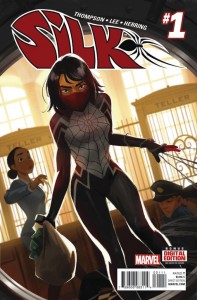 Silk #1 — Writer: Robbie Thompson; Art: Stacey Lee; Colors: Ian Herring
Silk #1 — Writer: Robbie Thompson; Art: Stacey Lee; Colors: Ian Herring
Venom: Space Knight #1 — Writer: Robbie Thompson; Art/Colors: Ariel Olivetti
Star Wars: Darth Vader #13 — Writer: Kieron Gillen; Art: Salvador Larroca; Colors: Edgar Delgado
These Marvel books are pretty good for all audiences, too: Robbie Thompson, a relative newcomer to comics with the last volume of Silk, has a lot of storytelling experience on the cult TV series Supernatural, and is developing a good reputation at books 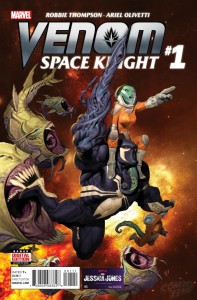 involving strong female characters, deep knowledge of Marvel continuity and effective use of action. This new volume of Silk (a girl who was bitten by the same spider who nipped Peter Parker, but spent ten years concealed in a bunker because blahblahblah Morlun Spider-Verse Ezekiel) demonstrates that; Stacy Lee’s yet another newer, manga-influenced artist who’s got an approachable, easy-to-like minimalist style. Venom: Space Knight is more straight-ahead space opera, with the Flash Thompson version of the symbiote-linked title character (just imagine trying to explain to someone who hadn’t read comics since the ’60s how Peter Parker’s high-school-bully
involving strong female characters, deep knowledge of Marvel continuity and effective use of action. This new volume of Silk (a girl who was bitten by the same spider who nipped Peter Parker, but spent ten years concealed in a bunker because blahblahblah Morlun Spider-Verse Ezekiel) demonstrates that; Stacy Lee’s yet another newer, manga-influenced artist who’s got an approachable, easy-to-like minimalist style. Venom: Space Knight is more straight-ahead space opera, with the Flash Thompson version of the symbiote-linked title character (just imagine trying to explain to someone who hadn’t read comics since the ’60s how Peter Parker’s high-school-bully  antagonist turned into that…), and Olivetti’s dark, detailed art (the opposite of Lee’s, and an indication of Thompson’s flexibility in working with such different partners) effective at the Star Wars-like goings-on. Then, there’s Star Wars itself, with this week’s Darth Vader offering the second part of a crossover involving the title bad guy (right after the conclusion of Episode IV: A New Hope) being shot down on a rebel-controlled planet where Luke (whom he doesn’t know is his son yet) just happens to be too; it’s a fun mix of old and new characters, set in a universe that any readers who’ve seen the films will be familiar with and appreciate: another good holiday gift.
antagonist turned into that…), and Olivetti’s dark, detailed art (the opposite of Lee’s, and an indication of Thompson’s flexibility in working with such different partners) effective at the Star Wars-like goings-on. Then, there’s Star Wars itself, with this week’s Darth Vader offering the second part of a crossover involving the title bad guy (right after the conclusion of Episode IV: A New Hope) being shot down on a rebel-controlled planet where Luke (whom he doesn’t know is his son yet) just happens to be too; it’s a fun mix of old and new characters, set in a universe that any readers who’ve seen the films will be familiar with and appreciate: another good holiday gift.
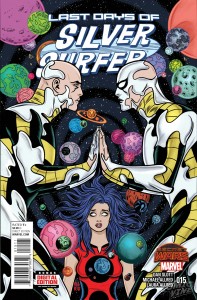 Silver Surfer #15 — Writer: Dan Slott; Art: Michael Allred; Colors: Laura Allred
Silver Surfer #15 — Writer: Dan Slott; Art: Michael Allred; Colors: Laura Allred
Carnage #2 — Writer: Gerry Conway; Art: Mike Perkins; Colors: Andy Troy
Angela: Queen of Hel #2 — Writer: Marguerite Bennett; Main Story Art: Kim Jacinto; Main Story Color: Israel 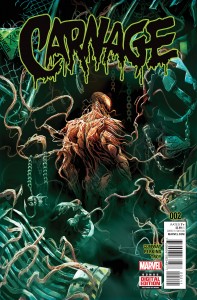 Silva; Substory Art: Stephanie Hans
Silva; Substory Art: Stephanie Hans
All-New Wolverine #2 — Writer: Tom Taylor; Art: David Lopez and David Navarrot; Colors: Nathan Fairbairn
Howling Commandos of S.H.I.E.L.D. #2 — Writer: Frank  Barbiere; Art: Brent Scoonover; Colors: Nick Filardi
Barbiere; Art: Brent Scoonover; Colors: Nick Filardi
Guardians of the Galaxy #2 — Writer: Brian Michael Bendis; Art: Valerio Schiti; Colors: Richard Isanove
Six more-mainstream Marvel books. I almost put Silver Surfer in with the all-ages comics, because it’s been a colorful, cheerful, trippy little tour of the universe, but this 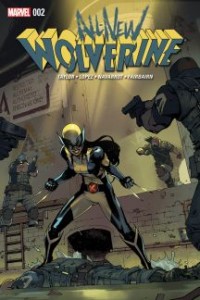 final issue is too philosophical, and depends too much on previous events, to be a good place to start (get a set of the earliest issues, or trades, and work your way up instead; Allred’s art alone is worth it, and inspires Slott’s pitch-perfect cosmic script). Carnage is not for younger readers, unless they’ve already seen, say, Hallowe’en; it’s Gerry Conway having fun with a B-movie monster/slasher flick, with Perkins’ dark, shiny horror art channeling a little of Clayton Crain. Angela is Marguerite Bennett doing a good job of taking the best
final issue is too philosophical, and depends too much on previous events, to be a good place to start (get a set of the earliest issues, or trades, and work your way up instead; Allred’s art alone is worth it, and inspires Slott’s pitch-perfect cosmic script). Carnage is not for younger readers, unless they’ve already seen, say, Hallowe’en; it’s Gerry Conway having fun with a B-movie monster/slasher flick, with Perkins’ dark, shiny horror art channeling a little of Clayton Crain. Angela is Marguerite Bennett doing a good job of taking the best 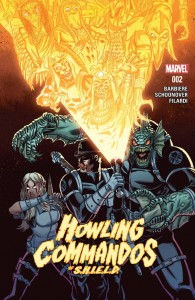 elements of Kieron Gillen’s previous work on the Asgardians and extending it; her dreamy-but-tough mythological tone, and two-lovers-against-the-universe plot, make it work. All-New Wolverine, on the other hand, stands out because of its art; David Lopez’s knack for faces that are simultaneously offbeat and grounded reminds me of Frank Quitely, and it’s a shame when his heroine is
elements of Kieron Gillen’s previous work on the Asgardians and extending it; her dreamy-but-tough mythological tone, and two-lovers-against-the-universe plot, make it work. All-New Wolverine, on the other hand, stands out because of its art; David Lopez’s knack for faces that are simultaneously offbeat and grounded reminds me of Frank Quitely, and it’s a shame when his heroine is  wearing her full-face mask and we can’t see her reactions. Howling Commandos of S.H.I.E.L.D. is for monster fans and continuity buffs (a small but loyal audience), who should find it sufficiently entertaining, and Guardians of the Galaxy involves the heroes meeting the bad guy (girl), defeating her momentarily (each member of the team getting a chance to show their powers), and then getting defeated in return, for a last-page cliffhanger; like HCofS.H.I.E.L.D., it’s meant to deliver the second chapter of a longer story, and does it effectively: no more, but no less either.
wearing her full-face mask and we can’t see her reactions. Howling Commandos of S.H.I.E.L.D. is for monster fans and continuity buffs (a small but loyal audience), who should find it sufficiently entertaining, and Guardians of the Galaxy involves the heroes meeting the bad guy (girl), defeating her momentarily (each member of the team getting a chance to show their powers), and then getting defeated in return, for a last-page cliffhanger; like HCofS.H.I.E.L.D., it’s meant to deliver the second chapter of a longer story, and does it effectively: no more, but no less either.
 DKIII: The Master Race #1 (of 4) — Story: Frank Miller and Brian Azzarello; Writer: Brian Azzarello; Pencils: Andy Kubert; Inks: Klaus Janson; Colors: Brad Anderson
DKIII: The Master Race #1 (of 4) — Story: Frank Miller and Brian Azzarello; Writer: Brian Azzarello; Pencils: Andy Kubert; Inks: Klaus Janson; Colors: Brad Anderson
If you approach this as a new Frank Miller Batman book… well, he didn’t do the main art (although he pencilled a stand-alone twelve-page Atom comic, plus covers, that’s inserted in the middle of it), and while he contributed to the story I’m guessing that meant a lot of meetings where Azzarello would describe the story enthusiastically and Miller would nod and say “OK” a lot. On the other hand, an Azzarello Batman book, with art by Andy Kubert and inked by Klaus Janson (the one member of this crew who did work on DKs I and II, and inked that Miller Atom story, too), is no small thing, and being set in Miller’s Wagnerian future America doesn’t hurt it one bit; it’s got smooth narration (those Miller talking-heads walls are great at delivering backstory), a high-action chase, that extra comic in the middle, and a gut-punch last page. Maybe we should just all shut up and enjoy it….
 Jacked #1 (of 6) — Writer: Eric Kripke; Art/Colors: John Higgins
Jacked #1 (of 6) — Writer: Eric Kripke; Art/Colors: John Higgins
Art Ops #2 — Writer: Shaun Simon; Art: Michael Allred and Matt Brundace; Colors: Laura Allred
Vertigo’s been launching a number of titles lately; Jacked, the new one here, is about a schlubby unemployed dad (he was a marketing director of a Blockbusters-like video store chain, and hasn’t been able to get a job since) whose dentist 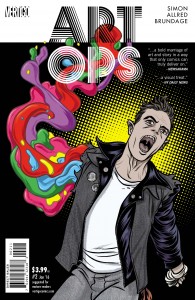 brother turns him on to some “brain steroids,” which make him into something of a minor superhero, at least at first, but will obviously lead to problems; it’s fine, although I’d swear Peter Mulligan has already written like five other Vertigo series just like it. Art Ops is more unique (although its arch art-school tone will be familiar) with Michael Allred, again, supplying most of the oomph to its tale of living masterpieces (a Mona Lisa yanked into the present day is a continuing character). Even it shows some Mulligan influence, since deep down it would love to be Shade, the Changing Man, and like that book it’s got more than enough weird charm to keep it going for a while.
brother turns him on to some “brain steroids,” which make him into something of a minor superhero, at least at first, but will obviously lead to problems; it’s fine, although I’d swear Peter Mulligan has already written like five other Vertigo series just like it. Art Ops is more unique (although its arch art-school tone will be familiar) with Michael Allred, again, supplying most of the oomph to its tale of living masterpieces (a Mona Lisa yanked into the present day is a continuing character). Even it shows some Mulligan influence, since deep down it would love to be Shade, the Changing Man, and like that book it’s got more than enough weird charm to keep it going for a while.
 Ringside #1 — Writer: Joe Keatinge; Art: Nick Barber; Colors: Simon Gough
Ringside #1 — Writer: Joe Keatinge; Art: Nick Barber; Colors: Simon Gough
Black Magic #2 — Writer: Greg Rucka; Art: Nicola Scott; Color Assists: Chiara Arena
Two newer indy books — Ringside is set in the world of pro  wrestling; with its main character a retired pug who gets pulled back into the game, tries to help a friend, gets beat up and seeks payback, it’s got noir attitude to spare. So does Black Magick, whose main character is a cop/Wiccan; its combination of police procedural and occult thriller, centered around a female lead, is like Vertigo’s recently-concluded Coffin Hill, with Rucka’s smooth tough-guy script and Scott’s detailed, realistic art (she’s worked on a number of DC comics, notable Secret Six and Earth 2) giving it more commercial appeal.
wrestling; with its main character a retired pug who gets pulled back into the game, tries to help a friend, gets beat up and seeks payback, it’s got noir attitude to spare. So does Black Magick, whose main character is a cop/Wiccan; its combination of police procedural and occult thriller, centered around a female lead, is like Vertigo’s recently-concluded Coffin Hill, with Rucka’s smooth tough-guy script and Scott’s detailed, realistic art (she’s worked on a number of DC comics, notable Secret Six and Earth 2) giving it more commercial appeal.
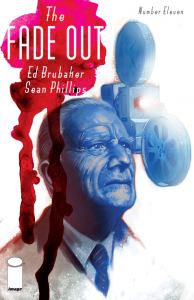 The Fade-Out #11 (of 12) — Writer: Ed Brubaker; Art: Sean Phillips; Colors: Elizabeth Breitweiser
The Fade-Out #11 (of 12) — Writer: Ed Brubaker; Art: Sean Phillips; Colors: Elizabeth Breitweiser
Outcast #13 — Writer: Robert Kirkman; Art: Paul Azaceta; Colors: Elizabeth Breitweiser
Saga #31 — Writer: Brian K. Vaughan; Art/Colors: Fiona Staples
 Hellboy and the B.P.R.D.: 1953: “The Witch Tree” and “Rawhead and Bloody Bones” — Writer: Mike Mignola; Art: Ben Stenbeck; Colors: Dave Stewart
Hellboy and the B.P.R.D.: 1953: “The Witch Tree” and “Rawhead and Bloody Bones” — Writer: Mike Mignola; Art: Ben Stenbeck; Colors: Dave Stewart
A couple of other, more-established indy books. The Fade-Out offers its penultimate issue, with its dark tale of postwar-Hollywood corruption and murder taking a 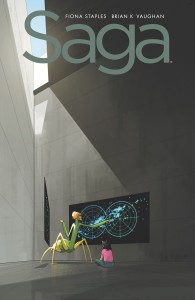 predictedly bloody turn as it races to its conclusion, while Outcast is smack in the middle of its run, with its beleaguered exorcists scoring both a victory and a defeat, and Kirkman and Azaceta knowing just when to dole out the shocking or twisty soap elements. So too for Saga, whose large alien cast is always surprisingly human, and whose sprawling plots dependably deliver at least two or three wtf? moments in every issue; this is a book that’s
predictedly bloody turn as it races to its conclusion, while Outcast is smack in the middle of its run, with its beleaguered exorcists scoring both a victory and a defeat, and Kirkman and Azaceta knowing just when to dole out the shocking or twisty soap elements. So too for Saga, whose large alien cast is always surprisingly human, and whose sprawling plots dependably deliver at least two or three wtf? moments in every issue; this is a book that’s 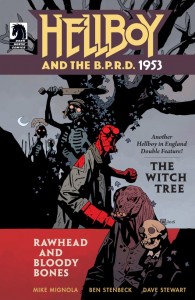 been very good at using those moments, the beautiful Fiona Staples art, and Vaughan’s easy-to-like characters to develop a devoted following. The indy master of that, though, might be Hellboy, whose Mignola-led crew has been courting fans of perfectly-pitched horror for over two decades; the two stories here (written by Mignola) and the ’50s focus on the title character’s early years, are a reminder of how solid its original concept of short, folk-tale-like occult comics has been, even as the over-arching mega-story has grown, branched out, almost ended the world, taken Hellboy to hell, and will begin to draw to a close sometime next year.
been very good at using those moments, the beautiful Fiona Staples art, and Vaughan’s easy-to-like characters to develop a devoted following. The indy master of that, though, might be Hellboy, whose Mignola-led crew has been courting fans of perfectly-pitched horror for over two decades; the two stories here (written by Mignola) and the ’50s focus on the title character’s early years, are a reminder of how solid its original concept of short, folk-tale-like occult comics has been, even as the over-arching mega-story has grown, branched out, almost ended the world, taken Hellboy to hell, and will begin to draw to a close sometime next year.



